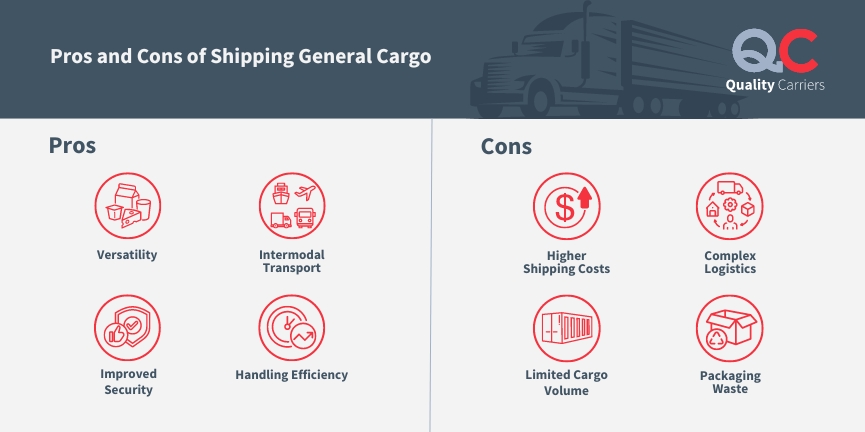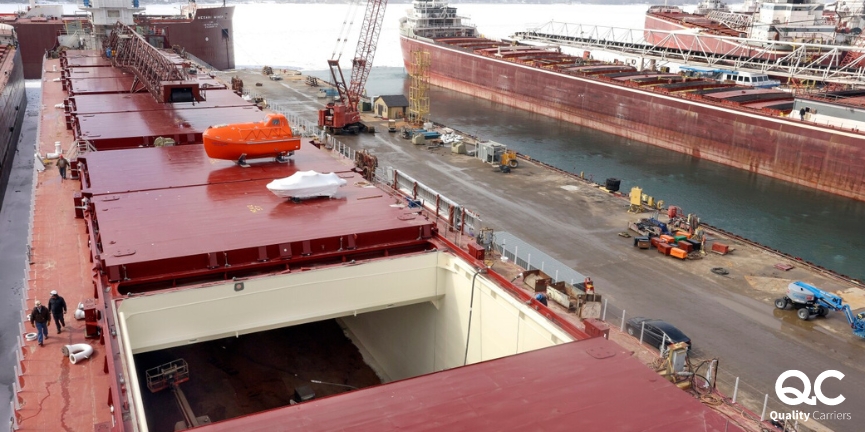Shipping cargo is a crucial part of global trade, but remember that not all cargo is shipped the same way. Depending on the type of goods being transported, they can be classified as general cargo or dry bulk cargo. Each category requires different handling methods, transportation modes, and packing standards.
In this blog, we’ll explore the differences between general and bulk cargo, the types of goods that fall under each category, and the pros and cons of shipping both types of freight.
What is General Cargo?
General cargo refers to goods packed individually, often in containers, bags, boxes, pallets, or crates, and shipped as separate units. These items are typically non-homogeneous, meaning they come in different shapes, sizes, and forms, requiring individual handling during loading, unloading, and transportation. General cargo can be transported using various modes of transport, including ships, trucks, trains, and planes.
Types of General Cargo
- Container Cargo – Goods packed in standardized shipping containers, commonly used for transporting consumer products, electronics, machinery, and more. Containerized cargo is easily transferred between ships, trucks, and trains, making it a popular choice for intermodal transportation.
- Break Bulk Cargo – Large items, such as vehicles, construction equipment, and heavy machinery, cannot be containerized due to their size or shape. They must be individually handled and loaded, often requiring cranes and specialized equipment.
- Pallet Cargo – These are goods stacked and secured on pallets for easy handling. Palletized cargo simplifies loading and unloading operations with forklifts and other handling equipment for smaller items, such as packaged food, beverages, and retail products.
- Neo-Bulk Cargo—Commodities such as steel products, logs, or paper rolls are not easily containerized or packaged individually. Due to their uniformity, neo-bulk cargo is often shipped as break bulk but handled as part of a distinct cargo category.
Pros and Cons of Shipping General Cargo

Pros:
- Versatility: General cargo includes various goods, from consumer products to machinery, and can be shipped in containers, pallets, or crates. This versatility allows efficient transportation across multiple modes, including road, rail, sea, and air.
- Intermodal Transport: General cargo is often containerized, allowing seamless transfer between different transportation modes (e.g., ships to trucks or trains) without needing to unload and reload the goods. This reduces handling time and ensures more excellent protection for the cargo.
- Improved Security: Packaged general cargo, especially when containerized, offers enhanced protection against theft and damage. Goods are stored in sealed units, reducing the risk of contamination or mishandling during transit.
- Handling Efficiency: Packaged and palletized general cargo can be quickly loaded, unloaded, and stacked, making operations at ports and distribution centers faster and more efficient, leading to quicker turnaround times.
Cons:
- Higher Shipping Costs: Packaging and handling requirements for general cargo can increase shipping costs compared to bulk cargo, especially when it involves specialized containers or equipment. The additional handling processes may also add to the overall cost.
- Complex Logistics: Shipping general cargo often requires careful planning and coordination, especially for mixed loads that include different types of goods. Managing various types of general cargo can complicate logistics and increase the potential for delays.
- Limited Cargo Volume: General cargo, particularly containerized cargo, is limited by the size and capacity of the containers or packaging used. This makes it less ideal for high-volume shipments than bulk cargo, which can carry more significant quantities of materials in a single shipment.
- Packaging Waste: The packaging required for general cargo generates a significant amount of waste, particularly with one-time-use materials such as cardboard, plastic, and pallets. This can increase disposal costs and have an environmental impact.
What is Bulk Cargo?
Bulk cargo is the method of transporting large quantities of unpackaged goods shipped in loose form, typically in large vessels or containers. These goods are homogeneous and are usually poured directly into the vessel’s holds. Bulk cargo is commonly transported via ships, trains, or trucks and includes materials like grains, coal, and crude oil. It is categorized into two types: liquid and dry bulk.
Types of Bulk Cargo
- Dry Bulk Cargo – Commodities like coal, grains, ores, and minerals shipped in large quantities in loose form. Dry bulk is often transported in specialized vessels like bulk carriers.
- Liquid Bulk Cargo – Consists of goods in liquid form, such as crude oil, chemicals, or liquefied natural gas (LNG), typically transported using tankers or specialized containers designed for liquid storage.
Pros and Cons of Shipping Bulk Cargo
Pros:
- Cost-Effective for Large Quantities: Bulk cargo is typically more cost-effective than general cargo when shipping large volumes of raw materials, as it eliminates the need for individual packaging. Moving massive quantities in a single shipment reduces overall transportation costs.
- Efficient Loading and Unloading: Bulk cargo is loaded directly into the vessel, truck, or railcar, streamlining the loading and unloading process. Specialized equipment, such as conveyor belts and pumps, helps handle bulk materials quickly, reducing labor and handling costs.
- Ideal for Commodities and Raw Materials: Shipping bulk cargo is ideal for industries like agriculture, mining, and energy, where large quantities of commodities (such as grains, coal, and oil) must be transported efficiently. Bulk shipping supports the movement of essential raw materials that drive these industries.
- Maximizes Cargo Volume: Bulk cargo is transported without packaging, maximizing the available space in the shipping vessel or vehicle. This allows for larger quantities of material to be moved at once, increasing transport efficiency.

Cons:
- Specialized equipment Required: Transporting bulk cargo often requires specialized equipment, such as bulk carriers, tankers, and silo trucks. This can increase the capital costs and limit the flexibility of shipping options. Bulk materials may also require specific care and storage conditions like moisture control or temperature regulation.
- Limitation in Handling: Bulk cargo requires dedicated infrastructure for handling and storing the goods, such as silos, tanks, or special facilities at ports. This lack of flexibility is challenging, especially in locations with limited or unavailable infrastructure.
- Higher Risk of Contamination and Damage: Without individual packaging, bulk cargo is more susceptible to contamination, spillage, or damage during transport. Exposure to moisture, pests, or improper handling can result in product quality or quantity loss.
- Limited Cargo Types: Bulk shipping is only suitable for certain goods, such as raw materials and liquids. It is inappropriate for finished products or goods requiring individual packaging, making it less versatile than general cargo shipping.
General vs. Bulk Cargo: Key Differences
The key difference between general and bulk cargo is how the goods are packaged and transported. General cargo involves individually packaged items handled and loaded into containers, while bulk cargo is shipped in large, unpackaged quantities. General cargo includes consumer goods and manufactured items, whereas bulk cargo typically involves raw materials like grain, coal, and liquids.
- Handling and Packaging: General cargo is packaged and handled as individual units, while bulk cargo is transported in large volumes without individual packaging.
- Cost: Bulk cargo is often cheaper to transport, as it doesn’t require the extensive packaging and handling needed for general cargo.
- Mode of Transport: General cargo can be shipped via containers across various transport modes, while bulk cargo typically requires specialized ships, trucks, or railcars.
- Types of Goods: General cargo includes consumer goods and machinery, while bulk cargo comprises raw materials like grain, coal, oil, and chemicals.
Conclusion
Understanding the differences between general and bulk cargo is essential for businesses shipping goods globally. Each method is unique, so it is necessary to choose the best option based on the type of goods and the volume being transported. By selecting the appropriate shipping method, companies can optimize costs and ensure efficient delivery.
FAQs
General cargo is shipped internationally using containers, pallets, or crates via sea, air, or land transport.
Bulk cargo generally includes raw materials like grains, coal, iron ore, crude oil, and chemicals shipped in large, loose quantities.
Bulk cargo is usually more cost-effective for large goods, while general cargo can be more expensive due to individual handling and packaging requirements.




